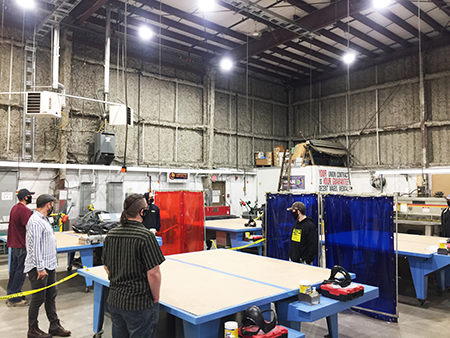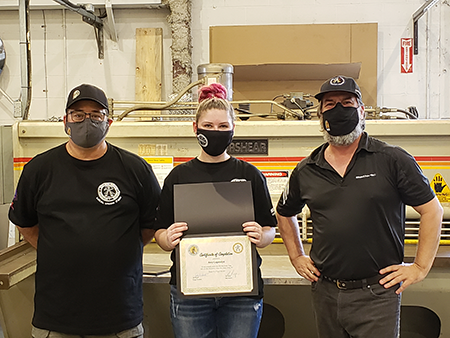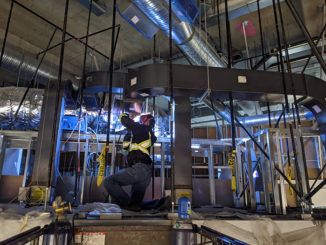
The Sheet Metal Workers Training Centre flexed its resilience muscles during COVID using technology, ingenuity, and first class support for its students
By / Jessica Kirby Photos courtesy of SMWTC
Pick up any newspaper, open any news app and there is no shortage of COVID-19 news—most of it disheartening. In that climate it can be hard to remember that with upset comes opportunity and with obstacles come solutions. The Sheet Metal Workers Training Centre (SMWTC) has created something positive from the circumstances that arose from the pandemic, and though it wasn’t always easy, it managed to keep its doors open, keep students safe and learning, and take important steps towards adopting the future of education.
Back in March when British Columbia went into initial restrictions, there were 41 students attending SMWTC in Levels 1, 2, and 3, and there was a lot of fear. Including the instructional staff, there were 48 in the building at once, which met the provincial health officer’s (PHO) 50-person limit and meant the school could stay open.
“At full lockdown, the limit was only five, so in a weekend everything changed,” says Training Co-ordinator Jud Martell. “We sent those students home on Friday and told them to wait for an email on Monday. On Monday, we taught everyone how to Zoom and had a Zoom meeting in which I introduced the new normal moving forward.”
And a new normal it was. Martell and the instructors spent the weekend putting the materials students would require to complete the final two weeks of their training online. They cobbled together a learning package, scrounged loaner computers for those who didn’t have them, and provided access to the server for all then-current students—a cohort they are calling The COVID Kids.
“We feel like this was the safest boat to be on in the construction trade during that time,” Martell says. “Other schools shut the doors and told students to go away. They didn’t even get to pick up their things.”
In many ways, the pandemic expedited a situation already in the making—the digitization of part of the training centre’s offering. Over the past two years Martell has inched the centre closer to accepting more technological advancements, a mision that started with implementing a server the staff could enter access remotely. The centre’s COVID response hinged on that implementation.
Getting through those first few weeks required several pivots or areas of adjustment for the training centre.
The first pivot was shutting early, following the decision of the trustees and following the PHO’s directives.

“We had one week’s notice and then went on to discuss with the training board what closing would look like,” Martell says. “The next was to develop a way to ensure 70% completion by offering the final two weeks of instruction online.”
The third pivot was helping students stay in school and collect EI because they would otherwise have to return to work in the middle of a crisis where their health and safety was not ensured onsite. The fourth pivot was extending the technical training as far as possible, which engaged the students in helping the centre design its remote capabilities and online modules and test its online platforms.
Although all of those decisions were made with the utmost consideration, not everyone reacted favourably. “There was a strong reaction from some who believed we were making the wrong call,” Martell says. “We shut down our socials for months. I truly believed that the best course was not to get out of the boat. My own son was in that class, so there is no doubt I made each decision thoughtfully.”
That was in March and April, in the heart of the panic.
After the initial action, SMWTC cancelled the remaining class schedule for 2020-2021 and spent two weeks informing students that a new schedule would be developed once it was safe and appropriate to do so. Because the classes are concurrent, all 40 classes scheduled between April 2020 and the end of 2021 had to be cancelled.
“At that time, some people still thought the whole thing would be over in June,” Martell says. “The plan was to see if we could come up with a safe, sustainable way forward.”
They scheduled a Level 4 class to begin June 15. It would run for four weeks remote learning and three weeks in the school, knowing that if necessary, the students could achieve 70% completion with the remote portion alone.
“That is how we built in resilience,” Martell says. “The idea was to get Level 4 through and get them to write the inter-provincial exam (IP).”
On June 15, the SMWTC started three classes of eight Level 4s. It started with a Zoom meeting that included 30 people and covered COVID protocol to train onsite. They gave everyone iPads and computers on loan, and set a goal to write the IP on July 31.
The staff and instructors spent four weeks designing the online learning modules and developing protocol for bringing the students in. That meant considering social distance, helping people feel comfortable, and having regular safety meetings.

“On July 30 we held a graduation ceremony—everyone graduated in masks, and people came and sat outside to watch from the lawn and parking lot,” Martell says. “The very next day we had three separate locations of eight each writing the IP, and we just heard back that all 24 passed. In ten years, if those 24 are the leaders of our industry, we will be in good hands.”
On August 24, SMWTC will be starting Level 1 and Level 2 classes running in parallel. A week later, the Level 3s will start, and there will once again be 48 students in total remote learning or on site. Making that work meant hiring six instructors and redesigning the entire space to have separate upstairs and downstairs areas where each class will only be on one level at a time. The schedule will have 24 online and 24 in class at one time, alternating by the week.
Into October, three more classes will begin—a Level 1, a sheet metal Level 3, and an architectural Level 1—to finish the year using the same protocol and scheduling formats.
Looking forward, SMWTC is leveraging its successes and setbacks during this transitional phase to begin offering its drafting portion online. As of the time of writing, Martell has secured a partnership with Microsoft from which the training centre will receive 300 student software seats and with AutoDesk for 1,200 student software seats. He is currently in discussions with Lenova about a hardware donation. The International Training Institute (iTi) has been the most dedicated partner through all of this implementing icredible, dedicated support to the training centre every step of the way.
“Standardizing the hardware and software is a major goal right now,” Martell says. “We need that so there is always a touchstone students can come back to if they get lost.”
Online learning has been the saving grace for the training centre, but it also has its challenges. It is harder to identify online when a student is struggling, and having instructors on-hand to motivate and give individual feedback is irreplaceable. As well, students’ physical fitness suffers when they are not onsite.
“We give students lots of breaks and asked them to exercise, go for walks, and look after their health,” Martell says. “We have a dedicated instructional staff that can’t check in with students the same way. There is also a provincial health emergency going on and the background health emergency—the opioid crisis—all coming together at once. It definitely isn’t easy.
“We are working in the ‘new normal’ while taking all of this into account and putting our students’ health first,” Martell says. “We have built resilience and flexibility into our programming and will continue to adjust things as necessary so the students get the most out of their training and we get the most out of the way they are helping our school evolve and grow.” ■



